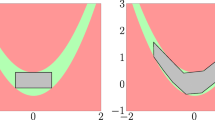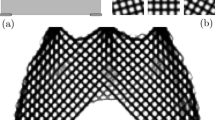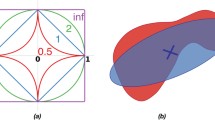Abstract
This work considers the problem of design centering. Geometrically, this can be thought of as inscribing one shape in another. Theoretical approaches and reformulations from the literature are reviewed; many of these are inspired by the literature on generalized semi-infinite programming, a generalization of design centering. However, the motivation for this work relates more to engineering applications of robust design. Consequently, the focus is on specific forms of design spaces (inscribed shapes) and the case when the constraints of the problem may be implicitly defined, such as by the solution of a system of differential equations. This causes issues for many existing approaches, and so this work proposes two restriction-based approaches for solving robust design problems that are applicable to engineering problems. Another feasible-point method from the literature is investigated as well. The details of the numerical implementations of all these methods are discussed. The discussion of these implementations in the particular setting of robust design in engineering problems is new.


Similar content being viewed by others
References
Abdel-Malek HL, Hassan AKSO (1991) The ellipsoidal technique for design centering and region approximation. IEEE Trans Comput Aided Des Integr Circuits Syst 10(8):1006–1014
Aubin J-P, Frankowska H (1990) Set-valued analysis. Birkhauser, Boston
Bank B, Guddat J, Klatte D, Kummer B, Tammer K (1983) Non-linear parametric optimization. Birkhauser, Boston
Bemporad A, Filippi C, Torrisi FD (2004) Inner and outer approximations of polytopes using boxes. Comput Geom 27(2):151–178
Ben-Tal A, Nemirovski A (1998) Robust convex optimization. Math Oper Res 23(4):769–805
Ben-Tal A, Nemirovski A (1999) Robust solutions of uncertain linear programs. Oper Res Lett 25(1):1–13
Ben-Tal A, Nemirovski A (2001) Lectures on modern convex optimization: analysis, algorithms, and engineering applications. SIAM, Philadelphia
Bertsekas DP (1999) Nonlinear programming, 2nd edn. Athena Scientific, Belmont
Bertsekas DP (2009) Convex optimization theory. Athena Scientific, Belmont
Bhattacharjee B, Green WH, Barton PI (2005) Interval methods for semi-infinite programs. Comput Optim Appl 30(1):63–93
Bhattacharjee B, Lemonidis P, Green WH, Barton PI (2005) Global solution of semi-infinite programs. Mathematical Programming, Series B 103:283–307
Boyd S, El Ghaoui L, Feron E, Balakrishnan V (1994) Linear matrix inequalities in system and control theory. SIAM, Philadelphia
Boyd S, Vandenberghe L (2004) Convex optimization. Cambridge University Press, New York
Chachuat B (2015) MC++: A Versatile Library for McCormick Relaxations and Taylor Models. http://www.imperial.ac.uk/people/b.chachuat/research.html
Diehl M, Houska B, Oliver Stein, Steuermann P (2013) A lifting method for generalized semi-infinite programs based on lower level Wolfe duality. Comput Optim Appl 54(1):189–210
Du K, Kearfott RB (1994) The cluster problem in multivariate global optimization. J Global Optim 5(3):253–265
Floudas CA, Gümüş ZH, Ierapetritou MG (2001) Global optimization in design under uncertainty: feasibility test and flexibility index problems. Ind Eng Chem Res 40:4267–4282
GAMS Development Corporation (2014) GAMS: General Algebraic Modeling System. http://www.gams.com
Geoffrion AM (1971) Duality in nonlinear programming: a simplified applications-oriented development. SIAM Rev 13(1):1–37
Grant M, Boyd S (2008) Graph implementations for nonsmooth convex programs. In: Blondel V, Boyd Stephen, Kimura H (eds) Recent advances in learning and control, lecture notes in control and information sciences. Springer, Berlin, pp 95–110
Grant M, Boyd S (2014) CVX: Matlab software for disciplined convex programming, version 2.1. http://cvxr.com/cvx
Günzel H, Jongen HTh, Stein O (2007) On the closure of the feasible set in generalized semi-infinite programming. Central Eur J Oper Res 15(3):271–280
Günzel H, Jongen H Th, Stein O (2008) Generalized semi-infinite programming: on generic local minimizers. J Global Optim 42(3):413–421
Halemane KP, Grossmann IE (1983) Optimal process design under uncertainty. AIChE J 29(3):425–433
Harwood SM, Barton PI (2016) Lower level duality and the global solution of generalized semi-infinite programs. Optimization 65(6):1129–1149
Hendrix EMT, Mecking CJ, Hendriks THB (1996) Finding robust solutions for product design problems. Eur J Oper Res 92(1):28–36
Hettich R, Kortanek KO (1993) Semi-infinite programming: theory, methods, and applications. SIAM Rev 35(3):380–429
Houska B, Logist F, Van Impe J, Diehl M (2012) Robust optimization of nonlinear dynamic systems with application to a jacketed tubular reactor. J Process Control 22(6):1152–1160
Kanzi N, Nobakhtian S (2010) Necessary optimality conditions for nonsmooth generalized semi-infinite programming problems. Eur J Oper Res 205(2):253–261
Khachiyan LG, Todd MJ (1993) On the complexity of approximating the maximal inscribed ellipsoid for a polytope. Math Programm 61(1–3):137–159
Klatte D, Kummer B (1985) Stability properties of infima and optimal solutions of parametric optimization problems. Lect Notes Econ Math Syst 255:215–229
Loeblein C, Perkins JD (1998) Economic analysis of different structures of on-line process optimization systems. Comput Chem Eng 22(9):1257–1269
Lofberg J (2004) YALMIP: A toolbox for modeling and optimization in MATLAB. In: 2004 IEEE international conference on computer aided control systems design, pp 284–289
Mattheij R, Molenaar J (2002) Ordinary differential equations in theory and practice. SIAM, Philadelphia
Misener R, Floudas CA (2014) ANTIGONE: algorithms for coNTinuous/integer global optimization of nonlinear equations. J Global Optim 59(2–3):503–526
Mitsos A, Lemonidis P, Barton PI (2008) Global solution of bilevel programs with a nonconvex inner program. J Global Optim 42(4):475–513
Mitsos A, Chachuat B, Barton PI (2009) McCormick-based relaxations of algorithms. SIAM J Optim 20(2):573–601
Mitsos A (2011) Global optimization of semi-infinite programs via restriction of the right-hand side. Optimization 60(10–11):1291–1308
Mitsos A, Tsoukalas A (2014) Global optimization of generalized semi-infinite programs via restriction of the right hand side. J Global Optim 61(1):1–17
Moore RE, Kearfott RB, Cloud MJ (2009) Introduction to interval analysis, SIAM, Philadelphia
MOSEK (2015) http://www.mosek.com/
Nesterov Y, Nemirovski A (1994) Interior-point polynomial algorithms in convex programming. SIAM, Philadelphia
Nguyen VH, Strodiot J-J (1992) Computing a global optimal solution to a design centering problem. Math Programm 53(1–3):111–123
Parkinson A, Sorensen C, Pourhassan N (1993) A general approach for robust optimal design. J Mech Des 115(1):74–80
Polak E (1987) On the mathematical foundations of nondifferentiable optimization in engineering design. SIAM Rev 29(1):21–89
Polik I, Terlaky T (2007) A Survey of the S-Lemma. SIAM Rev 49(3):371–418
Ralph D, Dempe S (1995) Directional derivatives of the solution of a parametric nonlinear program. Math Programm 70:159–172
Rocco CM, Moreno J, Carrasquero N (2003) Robust design using a hybrid-cellular-evolutionary and interval-arithmetic approach: a reliability application. Reliab Eng Syst Saf 79(2):149–159
Rückmann J-J, Shapiro A (1999) First-order optimality conditions in generalized semi-infinite programming. J Optim Theory Appl 101(3):677–691
Sahinidis NV (2014) BARON 14.0.3: global optimization of mixed-integer nonlinear programs, user’s manual. http://www.minlp.com/downloads/docs/baronmanual.pdf
Salazar DE, Rocco CM (2007) Solving advanced multi-objective robust designs by means of multiple objective evolutionary algorithms (MOEA): A reliability application. Reliab Eng Syst Saf 92(6):697–706
Schaber SD (2014) Tools for dynamic model development. PhD thesis, Massachusetts Institute of Technology
Scott JK (2012) Reachability analysis and deterministic global optimization of differential-algebraic systems. PhD thesis, Massachusetts Institute of Technology
Scott JK, Barton PI (2013) Bounds on the reachable sets of nonlinear control systems. Automatica 49(1):93–100
SeDuMi (2015): Optimization over symmetric cones. http://sedumi.ie.lehigh.edu/
Seifi A, Ponnambalam K, Vlach J (1999) A unified approach to statistical design centering of integrated circuits with correlated parameters. IEEE Trans Circuits Syst I Fundam Theory Appl 46(1):190–196
Stein O (2006) A semi-infinite approach to design centering. In: Dempe S, Kalashnikov V (eds) Optimization with mulitvalued mappings, chapter 1. Springer, Berlin, pp 209–228
Stein O (2012) How to solve a semi-infinite optimization problem. Eur J Oper Res 223(2):312–320
Stein O, Still G (2003) Solving semi-infinite optimization problems with interior point techniques. SIAM J Control Optim 42(3):769–788
Stein O, Winterfeld A (2010) Feasible method for generalized semi-infinite programming. J Optim Theory Appl 146(2):419–443
Still G (1999) Generalized semi-infinite programming: theory and methods. Eur J Oper Res 119:301–313
Stuber MD, Barton PI (2011) Robust simulation and design using semi-infinite programs with implicit functions. Int J Reliab Saf 5(3–4):378–397
Stuber MD, Barton PI (2015) Semi-infinite optimization with implicit functions. Ind Eng Chem Res 54(5):307–317
Sturm JF (1999) Using SeDuMi 1.02, A Matlab toolbox for optimization over symmetric cones. Optim Methods Soft 11(1–4):625–653
Swaney RE, Grossmann IE (1985a) An index for operational flexibility in chemical process design–part I: formulation and theory. AIChE J 31(4):621–630
Swaney RE, Grossmann IE (1985b) An index for operational flexibility in chemical process design–part II: computational algorithms. AIChE J 31(4):631–641
Tawarmalani M, Sahinidis NV (2005) A polyhedral branch-and-cut approach to global optimization. Math Programm 103(2):225–249
Tsoukalas A, Rustem B, Pistikopoulos EN (2009) A global optimization algorithm for generalized semi-infinite, continuous minimax with coupled constraints and bi-level problems. J Global Optim 44(2):235–250
Wechsung A (2013) Global optimization in reduced space. PhD thesis, Massachusetts Institute of Technology
Wechsung A, Schaber SD, Barton PI (2014) The cluster problem revisited. J Global Optim 58(3):429–438
Winterfeld A (2008) Application of general semi-infinite programming to lapidary cutting problems. Eur J Oper Res 191(3):838–854
YALMIP (2015) http://users.isy.liu.se/johanl/yalmip/
Acknowledgements
Funding was provided by Novartis Pharmaceuticals Corporation (IDOEJOAE572).
Author information
Authors and Affiliations
Corresponding author
Additional information
This research was funded by Novartis Pharmaceuticals as part of the Novartis-MIT Center for Continuous Manufacturing.
Appendices
Appendix
Convergence of bounding method from Sect. 5.1.1
Let \([\mathbf {v}^U, \mathbf {w}^L] \subset [\mathbf {v}^L, \mathbf {w}^U] \subset [{\bar{\mathbf {y}}}^L, {\bar{\mathbf {y}}}^U] \subset \mathbb {R}^{n_y}\). Let
for each \(j \in \{1, \dots , n_y\}\). Then it is easy to see that the “outer” interval \([\mathbf {v}^L, \mathbf {w}^U]\) is a subset of \([\mathbf {v}^U, \mathbf {w}^L] \cup \big ( \bigcup _j (Y_j^v \cup Y_j^w) \big )\); for any \(\mathbf {y}\in [\mathbf {v}^L, \mathbf {w}^U]\), each component \(y_j\) lies in one of \([v_j^L, v_j^U]\), \([v_j^U, w_j^L]\), or \([w_j^L,w_j^U]\), which is included in the definition of one of \(Y_j^v\), \([\mathbf {v}^U, \mathbf {w}^L]\), or \(Y_j^w\).
Thus
Let \(\alpha = \,\mathrm {diam}([{\bar{\mathbf {y}}}^L, {\bar{\mathbf {y}}}^U])\). Then \((w_k^U - v_k^L) \le \alpha \) for each k. If \(X' = [\mathbf {v}^L,\mathbf {v}^U] \times [\mathbf {w}^L, \mathbf {w}^U]\), then \((v_j^U - v_j^L) + (w_j^U - w_j^L) \le 2 \,\mathrm {diam}(X')\) for each j. Putting all these inequalities together one obtains
Thus assuming \([\mathbf {y}^L,\mathbf {y}^U] \subset [{\bar{\mathbf {y}}}^L, {\bar{\mathbf {y}}}^U]\) for all \((\mathbf {y}^L,\mathbf {y}^U) \in X\), this establishes that the bounding method described in § 5.1.1 is at least first-order convergent.
Rights and permissions
About this article
Cite this article
Harwood, S.M., Barton, P.I. How to solve a design centering problem. Math Meth Oper Res 86, 215–254 (2017). https://doi.org/10.1007/s00186-017-0591-3
Received:
Accepted:
Published:
Issue Date:
DOI: https://doi.org/10.1007/s00186-017-0591-3




